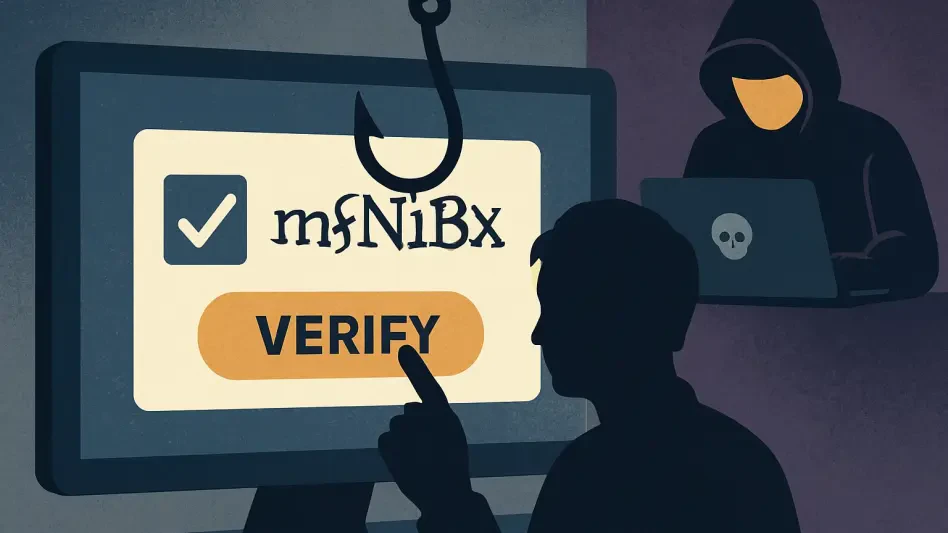In an era where digital security is paramount, a disturbing trend has emerged that threatens to undermine even the most basic online safeguards, as cybercriminals now harness artificial intelligence to create deceptive CAPTCHAs for phishing scams. These familiar tests, designed to differentiate humans from bots, are being replicated with alarming precision by attackers using AI tools. Unsuspecting users, believing they are interacting with legitimate security measures, often input sensitive information or click on harmful links, falling prey to sophisticated fraud. This alarming development highlights a significant shift in cybercrime tactics, where technology meant to protect is twisted into a weapon of deception. As phishing attacks grow more intricate, the line between genuine and malicious online interactions blurs, leaving individuals and organizations vulnerable to data theft and financial loss. The urgency to address this misuse of AI in cybercrime has never been more critical, prompting a deeper examination of its implications.
Unveiling the Deceptive Mechanism
At the heart of this emerging threat lies the ability of AI to mimic authentic CAPTCHA systems with chilling accuracy, tricking users into a false sense of security on fraudulent websites. These fake CAPTCHAs often appear indistinguishable from the real ones, prompting individuals to enter credentials or personal details under the guise of identity verification. Cybercriminals exploit this trust, using the harvested information for identity theft, unauthorized access to accounts, or even installing malware on victims’ devices. The sophistication of these AI-generated prompts showcases how far malicious actors have come in adapting cutting-edge technology for illicit purposes. Unlike traditional phishing attempts that relied on poorly designed pages or obvious red flags, these modern scams leverage realistic visuals and user-friendly interfaces to lower defenses. This evolution in attack methods underscores a broader challenge in cybersecurity: staying ahead of adversaries who continuously refine their techniques to exploit human behavior and trust in digital systems.
The Broader Landscape of AI-Driven Threats
Beyond fake CAPTCHAs, the misuse of AI in cybercrime reflects a larger trend where emerging technologies are weaponized at an unprecedented pace, posing significant risks to online safety. The democratization of AI tools, while fostering innovation, has also lowered the barrier for malicious actors to create convincing scams with minimal effort. Experts in cybersecurity express growing concern over how quickly attackers adapt to new advancements, often outpacing the development of defensive measures. This imbalance creates a precarious environment where traditional security protocols struggle to detect and mitigate AI-enhanced threats. The implications extend far beyond individual users, impacting businesses and institutions that rely on digital platforms for operations. As phishing schemes become more targeted and personalized through AI, the potential for widespread data breaches and financial losses escalates. Addressing this challenge requires a multifaceted approach, combining technological innovation with a renewed focus on user awareness to combat the ever-evolving landscape of cyber threats.
Strengthening Defenses Against Digital Deception
Looking back, the rapid rise of AI-powered phishing scams through deceptive CAPTCHAs marked a pivotal moment in the ongoing battle against cybercrime, demanding immediate and innovative responses. Cybersecurity experts have since advocated for the development of advanced detection algorithms capable of identifying AI-generated fakes by analyzing subtle discrepancies in design or behavior. Simultaneously, there was a strong push for stricter regulations and ethical guidelines surrounding AI development to prevent its misuse in malicious hands. Educating users to recognize suspicious prompts and verify website authenticity before sharing information proved equally vital in curbing these attacks. Technology providers also took steps to enhance security features, integrating multi-factor authentication and real-time threat monitoring to bolster defenses. Moving forward, collaboration between industry stakeholders and policymakers remains essential to anticipate future risks and implement proactive solutions. By staying vigilant and informed, the digital community can better safeguard against the clever tactics of cybercriminals exploiting AI for deception.








